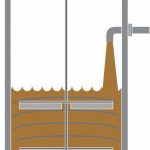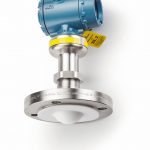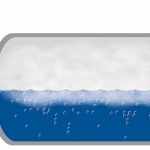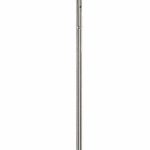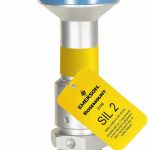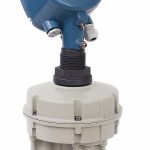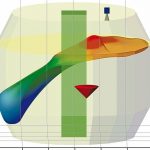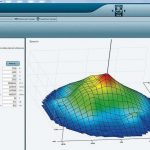Chemical processing plants are challenging environments for instrumentation, and the demands placed on level measuring devices are particularly arduous. Applications can involve toxic, corrosive, flammable or explosive materials, with wide variations in temperature and pressure as well as problematic media characteristics such as steam, dust, foam, turbulence and condensation. Such factors can influence level measurement accuracy and reliability. However, the enhanced functionality provided by the latest generation of devices is helping to overcome these challenges, increasing the safety of processes, plants and personnel and helping plant operators cut their running costs by making processes more efficient.
Blending tanks
In mixing applications, there are several challenges that must be mastered by level measuring devices including heavy turbulence, whirlpooling, foam, condensation, antenna build-up and disturbances such as multi-level agitators, inlets and heating coils. For this type of application, non-contacting radar transmitters are the most appropriate technology to deploy. Although they can handle agitation, their success depends on the amount of turbulence in the tank, as this can cause a loss of signal strength. Among the advances in this area are dedicated software algorithms, which can counteract the effects of turbulence as well as obstacles, foam and rapid level changes. Alternatively, bypass pipes featuring self-contained chambers or stilling wells can be used to isolate the surface from turbulence.
Non-contacting radar transmitters use either pulse radar or frequency modulated continuous wave (FMCW) techniques to perform the measurements. Although FMCW technology is a perfect match for this kind of application due to its greater accuracy and sensitivity, it traditionally uses more electrical energy and thus has typically only been deployed within four-wire devices. Installing four-wire devices often necessitates additional cable infrastructure, which is disruptive, costly and time-consuming. This has led to some users sacrificing the additional accuracy and reliability of FMCW devices and opting instead for two-wire transmitters based on pulse technology. Emerson’s Rosemount 5408 Level Transmitter gets to grips with the problem of high energy requirements for FMCW technology. Its superior energy efficiency allows power and communication to be provided by two wires, hence avoiding the need for additional infrastructure and enabling quick installation. As a result, the FMCW devices can be installed in a far greater number of mixing and blending applications, helping to improve measurement accuracy and reliability.
Reactor vessels
Vapours, foam and turbulence are usually present in reactor applications. In addition, the density of liquids can change as part of the reaction, and high temperatures and variable pressures are standard. All these challenges can affect level measurement accuracy. Non-contacting radar transmitters are again a very good measurement solution as they do not need to compensate for changes in density. Also, pressure variations, high temperatures and reaction vapours will not affect the accuracy of the measurements. The Rosemount 5408 offers all-polytetrafluoroethylene (PTFE) process seal antennas, developed specifically for demanding applications such as reactor vessels and ideal for handling corrosive media or high condensation levels. These antennas provide better pressure and temperature ratings compared to older devices. Wetted parts are likewise made from PTFE to maximise corrosion resistance. The Signal Quality Metrics diagnostics package, which detects abnormal process conditions such as a dirty antenna or foam and enables preventative maintenance to be scheduled, avoiding process upsets or shutdowns, is a further benefit.
Steam generation
Accurate level control in boilers is critical as a means of ensuring safe and efficient operation, but it can be very challenging to perform level measurements in such high-pressure and high-temperature applications, where the steam is saturated. Media density changes can result in measurement errors of up to 30 %. Traditional technologies such as displacers and differential pressure (DP) transmitters must compensate for these changes, in order to provide an accurate reading. These methods tend to require extensive maintenance, which adds to the lifecycle cost of the device. GWR transmitters, which can withstand extreme temperatures and pressures, represent a good solution here. Since GWR technology measures the surface of a liquid directly, it is completely independent of density, thus eliminating the need to compensate for density changes. GWR also has a robust design and no moving parts, leading to increased reliability and minimal maintenance costs.
One important consideration within this application is that the dielectric properties of feedwater are altered during the phase change from liquid to steam. For example, in saturated steam conditions when steam is under high pressure, its dielectric increases. This affects radar technology, as the propagation of the microwaves used to perform level measurements will slow down, provoking a measurement error of up to 50 % if the level reading is not compensated. Emerson’s Rosemount 5300 Series Level Transmitter overcomes this challenge by using dynamic vapour compensation, which continuously compensates for changes in the dielectric constant in the vapour space. The compensation takes place in the transmitter electronics and a corrected level measurement is provided to the control system. No additional compensation is required and the error rate can be reduced to 2 % or less.
Storage and process tanks
Agitation, heating and condensation are common challenges associated with general storage and process tanks. Traditional level measurement technologies such as pressure sensors, load cells and mechanical or ultrasonic devices are density-dependent as well as sensitive to contamination and require frequent maintenance. Many organisations therefore use either non-contacting radar or GWR devices for level measurement to determine inventory accurately and maximise the use of available storage capacity. Vibrating fork level switches are typically employed in conjunction with radar devices to perform essential safety functions.
Level measuring devices used as part of a safety instrumented system, for example for overfill prevention, must undergo regular proof-testing to ensure they meet the required safety integrity level. This can involve considerable time, effort and cost and present a safety risk. Both the Rosemount 5408 Level Transmitter and Emerson’s Rosemount 2140 Vibrating Fork Level Detector enable proof-testing to be performed remotely from the control room with minimal process interruptions, since they do not need to be removed from the vessel to be immersion tested. This makes the procedure significantly safer, as operators no longer have to physically access the device, allowing them to stay off the top of the tank and avoid working at height, where they could potentially be exposed to hazardous substances.
Shutting down the process is expensive, so minimising downtime for testing saves money. Modern remote proof-testing is far quicker than complex, conventional methods, enabling substantial savings to be achieved. The process is taken offline for only a matter of minutes, during which time multiple devices can be tested simultaneously ‘on the bus’. Furthermore, selecting a modern overfill prevention device with high diagnostic coverage, resulting in a significant reduction in dangerous undetected failures, means proof-testing can be carried out less frequently, again cutting down the test time needed to meet regulations.
Solids
For bulk storage of solids in larger vessels or warehouses, measurement inaccuracy can lead to a serious discrepancy in product volume. Highly accurate measurement technology is therefore essential and acoustic scanning is a popular choice. The latest scanner generation not only provides continuous online volume measurement but also offers 3-D visualisation of the peaks and troughs formed by a shifting solids surface. By showing how the material is distributed within the vessel, this 3-D mapping helps to prevent the threat of structural damage due to uneven loading while optimising storage capacity and improving production efficiency.
Emerson’s Rosemount 5708 3D Solids Scanner offers functionality to further improve safety and support the continuous analysis of product flow and movement by dividing a large vessel or warehouse interior into as many as 99 smaller, virtual sections. The operator can then monitor each section individually, so that if too much material builds up in one area, filling points can be switched and/or trucks alerted of the risk. This improved control over filling and emptying enables an even distribution to be continuously maintained across the surface, allowing the vessel’s capacity to be utilised more efficiently. It also helps to increase safety, as filling and emptying operations can be performed automatically from the control room rather than requiring someone to climb inside the vessel.
Users of these devices can now automatically calculate the centre of gravity for the vessel’s contents with every reading. The software generates an alert if the centre of gravity moves out of its predefined space, enabling remedial action to be taken immediately. This minimises the risk of structural damage and lets maintenance be carried out only when actually necessary.
In smaller vessels used for process control applications, the surface level can change rapidly because of the speed at which material enters and exits. Radar devices respond quickly to level changes, making them an appropriate solution. GWR is especially well-suited for vessels with a diameter of less than 10 m (33 feet) and containing powders or small granular materials, where the installation area is restricted. As the vessel height increases, wear on the probe becomes more of a factor for its suitability of use. Non-contacting radar has no restrictions with respect to the weight of the material and can be used in applications where GWR may not be ideal because of pull forces or concerns about probe breakage. Non-contacting radar can see more of the surface than GWR, so it will be slightly more accurate.
Pump lubrication
Level measuring devices can also be used to help protect critical pumps. A continuous supply of lubrication oil is typically provided from a lube oil reservoir and it is crucial that the level is monitored accurately. Too low and there is a risk of equipment damage, which could lead to a costly process shutdown. Too high and the potential overspill or leakage will constitute a safety hazard. Among the common challenges for level measurement technology are high vibration and limited access in skid-mounted or smaller tanks. Floats or DP transmitters with a wet reference leg system have high maintenance requirements and there is a risk of leakage with the piping for DP transmitters, while floats are prone to sticking. Consequently, automated monitoring systems are becoming much more prevalent.
Vibrating fork level switches are a more reliable solution for these applications. When the oil level drops to a defined low point, the switch sends a signal that alerts maintenance workers, who can address the issue before there is any risk of pump damage. Similarly, if the oil level rises to a defined high point, an alarm is output to prevent the threat of overspill. A lack of cable infrastructure can be a problem when implementing automated technology, but the latest vibrating fork level switches overcome this by offering wireless connectivity. This streamlines the installation process and delivers real-time data to maintenance staff, resulting in increased pump protection and lower operating costs.
Advanced diagnostics in the latest generation of devices further support reliability by enabling operators to continuously monitor their electronic and mechanical health. Any build-up, fork blockage or excessive corrosion is detected, indicating that maintenance may be required and allowing it to be scheduled during planned downtime, therefore increasing efficiency.
Online search: cpp0219emerson






